Blogs
Original post can be found here: https://adamkaraoguz.substack.com/p/tinkering-with-the-scaffolding
Disclaimer: This is a smorgasbord-style collection of some connections I’m putting together. This piece is going to serve as a first effort to put these thoughts together, and then I’m going to expand, build, refine, and simplify. I want to clear this off my cognitive plate in draft form so I can return to it later. There will likely be some misfires (haha, some) in this as I tighten up the shot group.
Part I: The Arena
1. Three Spheres of the Planet
2. Three Domains, 3 C Words
3. The Litany Of Shit(TM)
Part II: The Agent
4. Psychotechnology of Story
5. OODA
6. AAA Model
Part III: The Agency
7. Five Worldviews
8. TIMN
9. Trivium University
Bonus (Aspects of Arena, Agent, and Agency):
10. UTOK
In his “Awakening From the Meaning Crisis” series on YouTube, Cognitive Scientist John Vervaeke sets up the “Arena/Agent/Agency” Triad. He actually talks about “Affordances” a bit more than Agency, but I’m going with Agency for now because I think they are pretty tightly coupled. Note—I’ve taken these definitions from the live transcripts of the Meaning Crisis videos, so he may have a more articulate definition than I am portraying. He defines the Arena just how it sounds—it’s a “place where you know how you can act, where things belong, and what actions are appropriate.” He defines an Agent as someone “capable of pursing goals, someone able to organize your cognition and behavior so your actions fit the situation.” Like a (American) football player in a packed stadium as denoted below in my culturally imperialistic Arena chart below. Through this Agent-Arena relationship, the third thing is created, the Agency to make moves. One of Vervaeke’s examples is picking up a coffee mug. It’s an object in the Arena. But the Agent has the capacity to lift it, by virtue of neurological coordination, stable temperature, the mug handle, etc. That Affordance is co-created by both the Agent and the Arena and is critical. It’s in the relationship between the things that the value is created. Here’s a primer on his 4P’s of Knowing (Propositional, Procedural, Perspectival, and Participatory) if you’ve never seen it.
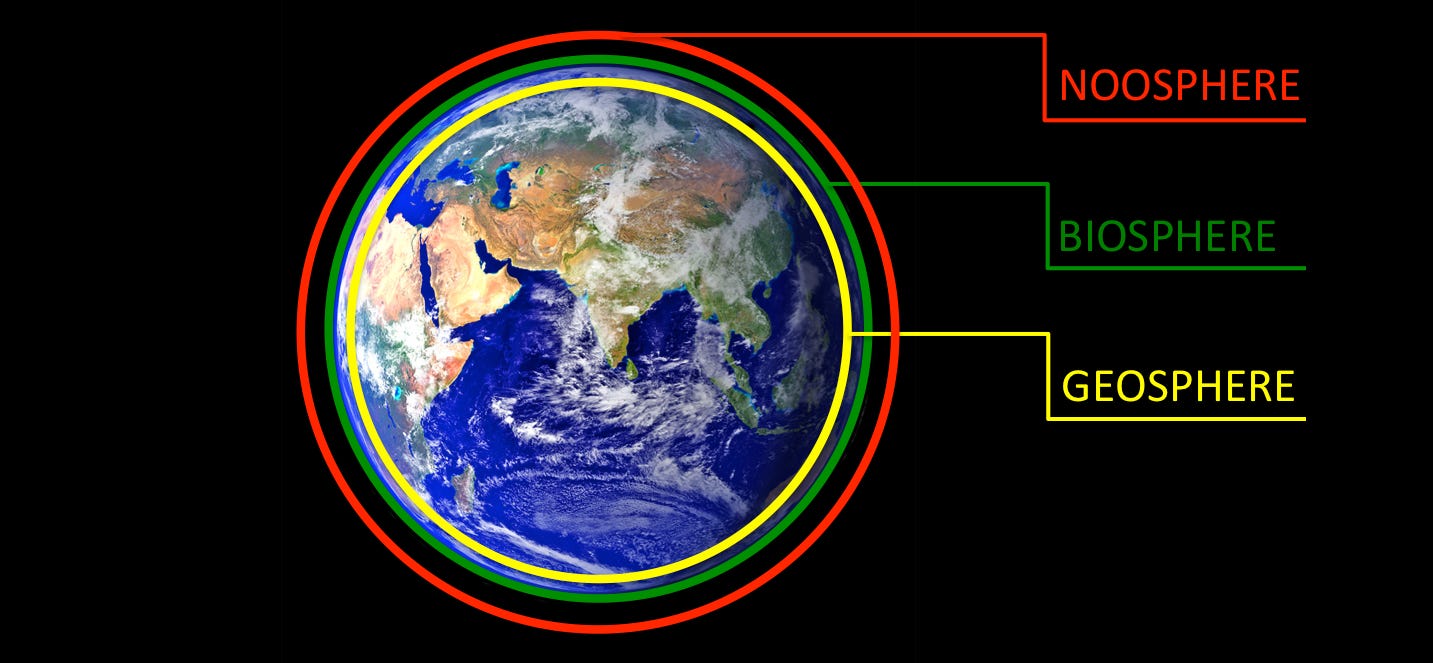
1. Three Spheres: Simply put, dividing our planetary home into three domains. There are some interesting videos about the Noosphere here. The chair of the department I graduated from out at Naval Postgraduate School, Dr. John Arquilla, discusses the Noosphere at length in: Whose Story Wins—The Rise of the Noosphere, Noopolitik, and Information-Age Statecraft.
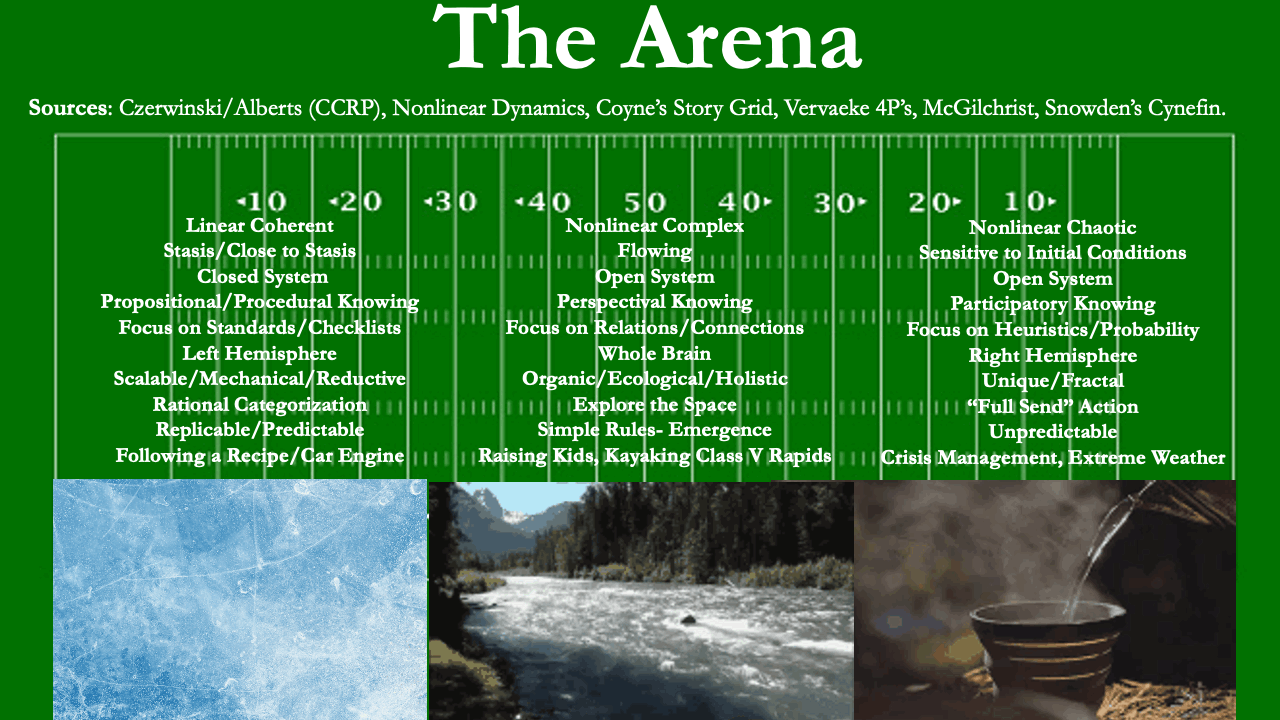
Author Synthesis of Sources
2. Three Domains, 3 C Words: I’ve listed some of the main sources above for this model. Of note, the Cynefin model switched “simple” to “clear” at some point in the recent past, which I really like, so I would like to offer “Coherent” to denote both the “Clear” and “Complicated” domains that Snowden talks about. I’ve always liked the metaphor of H2O for this because water figures so heavily in Taoist thinking, which everyone should be getting a passing familiarity with. Lao Tzu is the hipster nonlinearity guy—he was into it way before it was cool. Ice depicts the static/tyrannical/ordered domain, Steam the capricious/anarchic/chaotic domain, and water the flowing/free/complex domain. I’ve thrown in some Vervaeke and McGilchrist here to denote some best practice ways of thinking for the domains, which I will go into later on. The point here is that for the most part, we should be keeping things toward the middle of the field. We need requisite diversity and variety, which means pockets of total order and chaos are ok, but we should keep doing the “complexity shuttle” back and forth between say, the two thirty-yard lines in this blatant attempt at ugly Americanism.
Caveat: This diagram is attempting to describe the usual “propensities” of a given context. In reality, any situation has the potential to trip from one domain to any of the others based on various factors— flip from clear to complicated within the coherent domain, shift over to complex, or trip into chaotic.
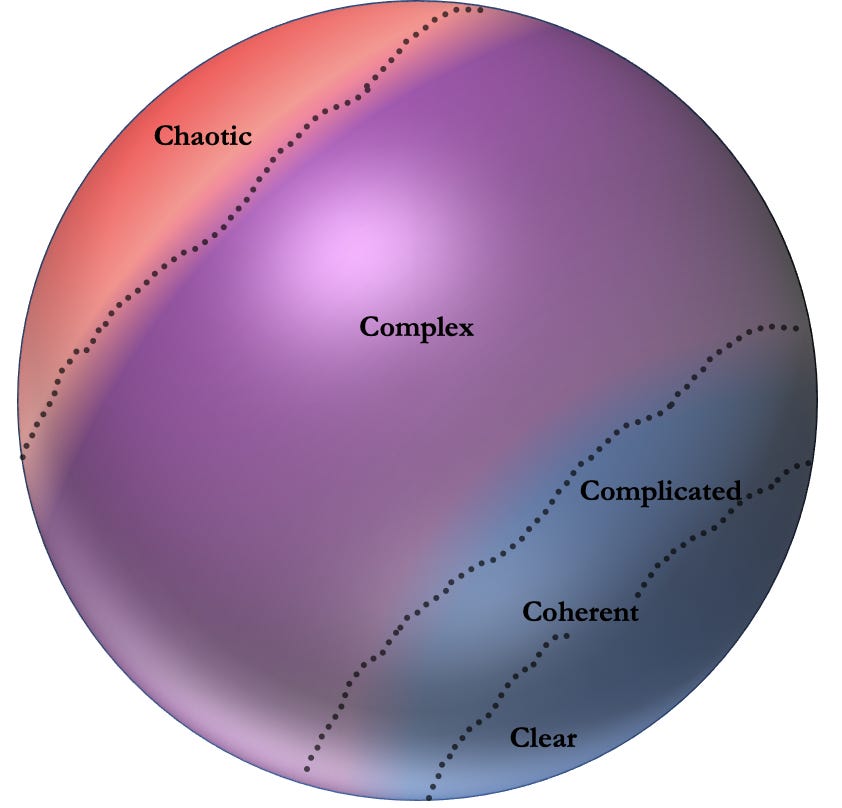
Author conception of the 3 C’s domains of Coherent, Complex, and Chaotic
For this graphic, I wanted to depict what we normally see in a more three-dimensional format. The takeaway is that although we are constantly trying to “rationalize” and get our processes into the coherent realm, most of our reality is not that easy. There are processes and things that are in that realm— Things that are linear are typically additive, replicable, and proportional. Linearity is responsible for a great deal of our modern world and its wonderous inventions. But there are limits in its ability to scaffold reality, although that doesn’t stop humans from trying.
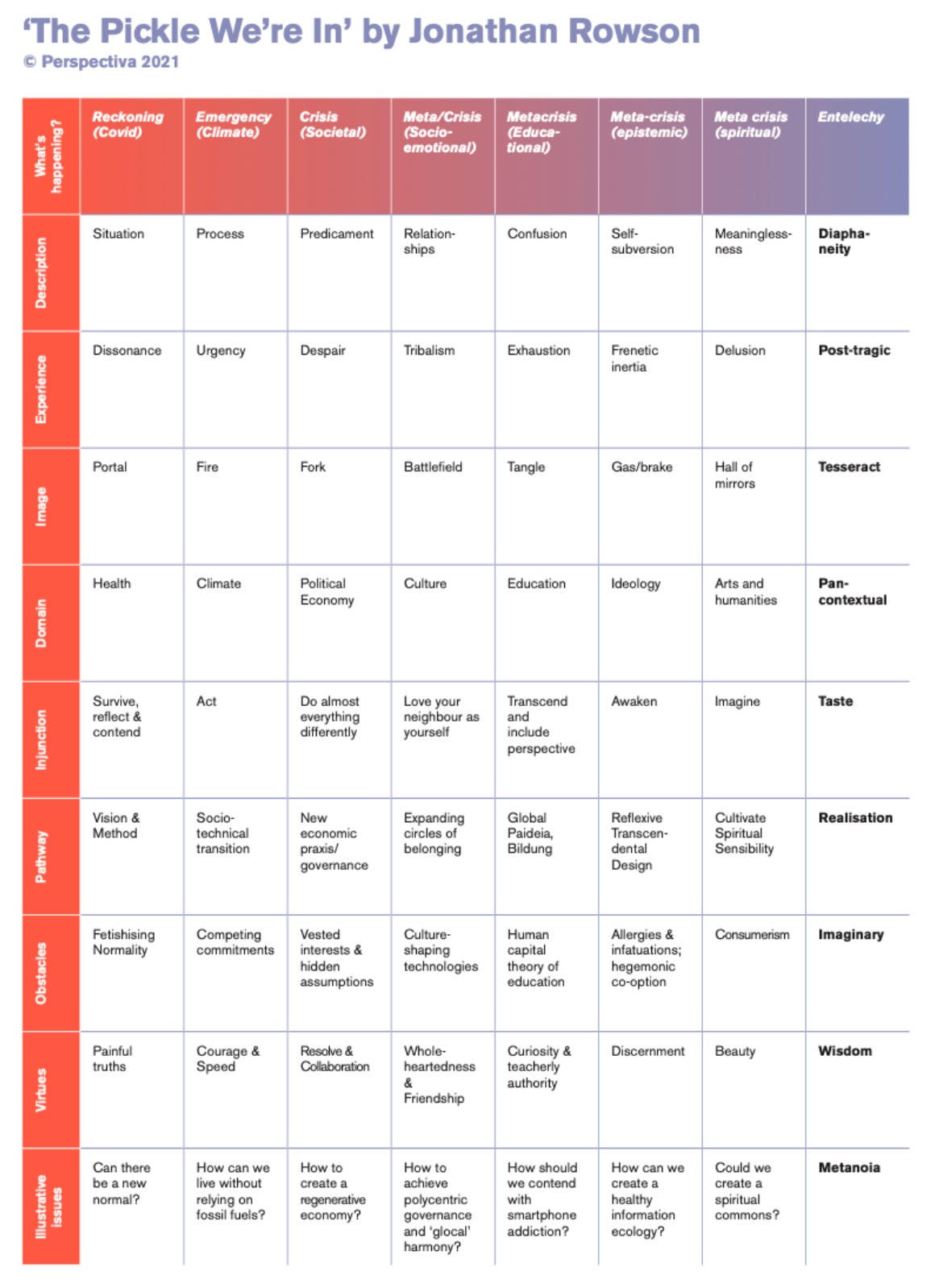
Metacrisis, courtesy of Perspectiva
3. The Litany of Shit (TM): This is a term of art that Jim Rutt created to describe the current Metacrisis, Polycrisis, take your pick of train wreck style description of what is happening at present—the nonlinear confluence of psychological, social, economic, political, and environmental problems crashing together in an unholy symphony. I’ve written about the Liminal Web characterization of it here, and there is plenty of great content out in the interwebs that we need not rehash here. Suffice to say, it’s an interesting time to be alive. A great deal of long-term cycles are crashing together at once in the 2020s, so strap in, it’s going to get stranger.
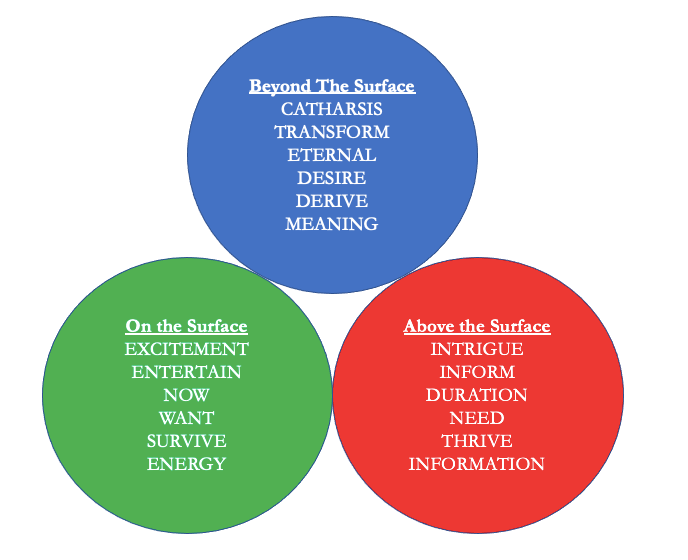
Story Grid Planes of Perception
4. The Psychotechnology of Story: This is a tool humans have created over the eons to assist in our advancement as a species. I’ve begun the process of talking about this here. The power of story gives the Agent in the Arena the vicarious experience with which to navigate a complex reality, one of the recommendations I discuss in my master’s thesis on combat decision making.
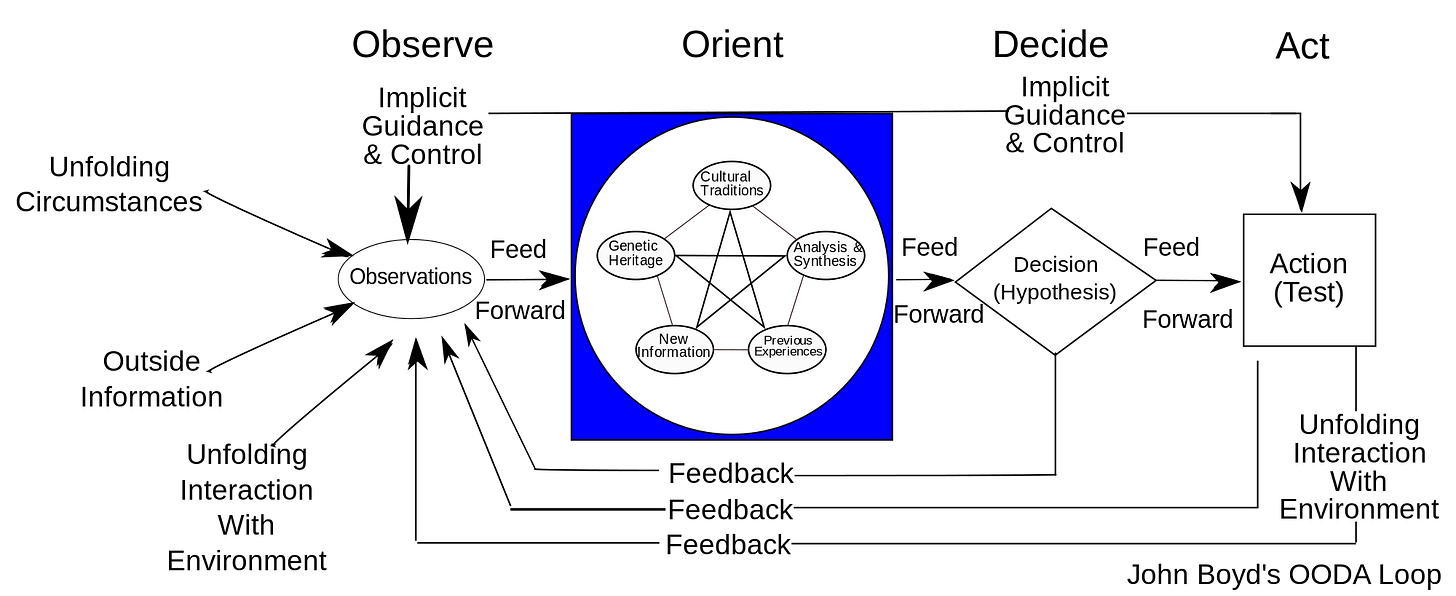
OODAing so hard
5. Boyd’s OODA: In the immortal words of Dave Mathews, so much to say. Boyd’s framework for interacting with a complex and chaotic reality is still misunderstood to this day. I compare some of Boyd’s thinking to Storytelling here.
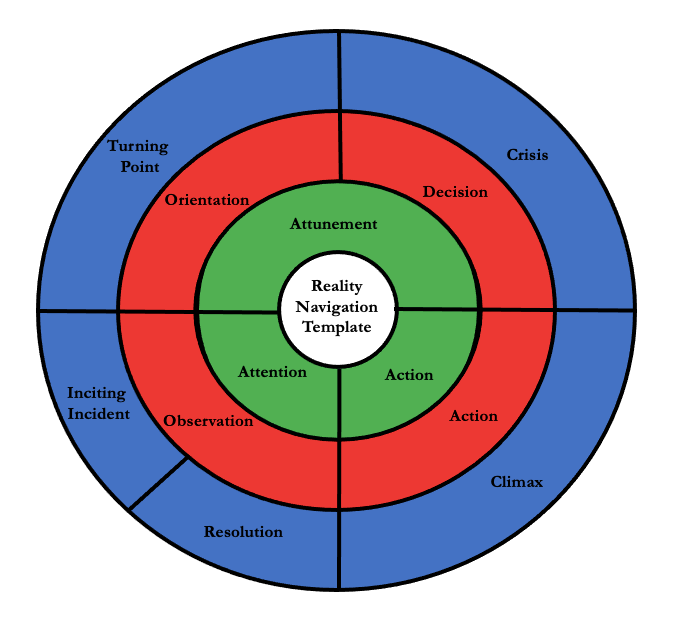
Outer Circle: 5 Commandments of Story (Coyne)
Middle Circle: OODA Loop (Boyd)
Inner Circle: AAA Model
6. AAA Model: This is something I’m noodling on. There are plenty of three step models of cognition and dealing with the world out there—this is just another one working to make sense of sense-making.
Definitions, According to Merriam Webster
Attention: Condition of readiness involving especially a selective narrowing or focusing of consciousness and receptivity; Observation, Notice.
Attunement: Bring into harmony; Make aware or responsive.
Action: Thing done; Deed; Behavior, Conduct; Initiative, Enterprise.
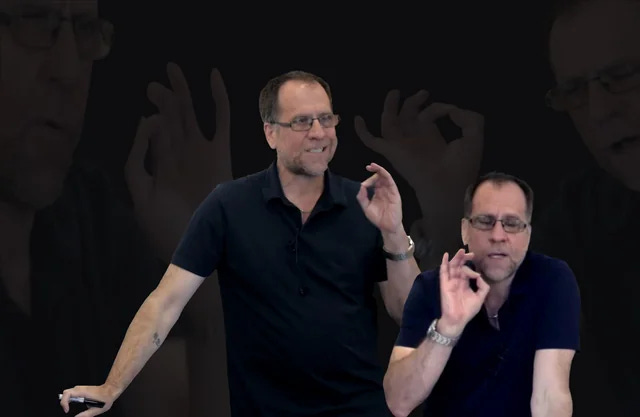
When the Grip is Optimal.” Source—Vervaeke Subreddit
I will cover the first and last phase, because they map pretty easily onto both OODA and the Story Grid 5Cs. Attention equates to the Resolution and the Inciting Incident phase of the Story Grid 5Cs, and Observation in the Boydian model—the sensory inputs of the Agent. Action is simply Action in OODA, and in the 5Cs, it relates to the climactic decision step of the protagonist.
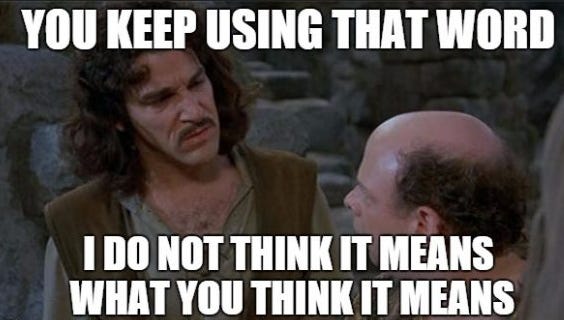
What do I mean by Attunement?
Attunement is where things get a little different. It maps to both the Turning Point Progressive Complication and the Crisis from the 5Cs, as well as the Orientation and Decision phases of OODA. Attunement is the critical step of this three-stroke iterative cycle of Attention, Attunement, and Awareness. Where Orientation is the schwerpunkt of OODA, Attunement reflects a higher-level process. My sense right now is that Orientation is part of Attunement, but it’s not fully capturing what’s going on there. Vervaeke talks about it a great deal in his course, as does Shawn Coyne as part of Story creation. More specifically, the concept of Worldview Attunement, which is posturing, comporting, aligning, connecting yourself properly to reality. It is similar, but not the same as Boyd’s definition of Orientation, “a many-sided cross-referencing process of projection, empathy, correlation, and rejection.” Where Orientation is focused on tactical success, Attunement is looking more strategically.
As with Boyd’s Orientation, this is occurring behind the Markov Blanket that separates the Agent from the Arena. There is however, a good deal of Distributed Cognition (4E) going on here:
Embodied: Involving the entire body of the living system (brain and body).
Embedded: Displays layers of co-determination with physical, social, and cultural aspects of the world.
Extended: Offloaded into biological beings and non-biological devices to serve a variety of functions that would be impossible (or too difficult) to be achieved by only relying on the agent’s own mental processes.
Enacted: Meaningful relationships determined by an adaptive two-way exchange between the complexity of living creatures and the environments they inhabit and shape.
Attunement is connected intimately to Vervaeke’s Recursive Relevance Realization, and what he calls “optimal grip”, to denote a proper relationship to reality. Attunement brings a numinous element to the process of sense-making not present in Boyd’s Orientation. In the words of Shawn Coyne, Attunement is about connection to the node (self), the network (group), and network of networks (world). When that connection is good, true, and beautiful, a prescriptive path emerges. This is why we can combine the Orientation and Decision phases of OODA into one—once Attunement happens, the proper course of action presents itself.
One of the sundry problems today is that our modern and post-modern world have divorced any sense of the numinous from our daily lives. In our desire not to offend and create any more discord in the world than there already is, we don’t speak of such things. Some of us have a religious faith, while others are atheists, with a “spiritual but not religious” middle ground of various constructions. When we don’t speak of a higher moral plane, the conduct of humanity descends to mercurial concerns. Whether we think there is an overt God, or simply want to revere Life, Nature and/or the Cosmos, we must return a respect for a higher realm to our conceptions of conduct. Now, we don’t have to. We can continue on as is—but we can see where that has gotten us. We have to recapture the reverence for something larger than our baser desires and short-term urges. What I’m getting at here is that there are things more important than simple day to day, survival/grind level concerns. Most people understand this and it seems almost silly to point out. But with a widespread loss of faith in the west, humans are struggling to figure out how to be in relation to something beyond the material plane. I’m not saying this is all mankind— I am sensitive to Dave Snowden’s critique of the meaning crisis that it’s all within the minds of disaffected westerners, while the rest of the world struggles with drought, famine, wars, and other exististential problems. Maybe he’s right— but the fact remains that the WEIRDos in the industrialized world have to get their act together if we want to effectively grapple with the “Litany of Shit” we’re faced with.
Psychiatrist and Literary Scholar Iain McGilchrist, in his works The Master and His Emmissary and The Matter With Things, he discusses in great detail the differences between the hemispheres of the brain. Note– this is a different concept than the classic, one side is artistic, the other logical. In reality, there is a great deal of overlap in the hemispheres, as you would expect in a networked, nonlinear dynamical system. However, there is a great deal of evidence, based on the study of patients with injury of one hemisphere or the other in discernable differences. According to McGilchrist, the right hemisphere is better at seeing things as they are pre-conceptually – fresh, unique, embodied, and as they ‘presence’ to us, or first come into being for us. The left hemisphere, then, sees things as they are ‘re-presented, literally present again’ after the fact, as already familiar abstractions or signs. One could say that the left is the hemisphere of theory, the right that of experience; the left that of the map, the right that of the terrain. The left hemisphere is optimized for exploiting, for apprehending (capturing) things, while the right is optimized for exploring and comprehending (understanding). McGilchrist’s main contention is that mankind at present is ruled too strongly by the Emmissary (Left Brain), rather than the Master (Right Brain). We need a balanced presentation to the world in order to be in it fully. This is another concept I’m trying to get at with Attunement.
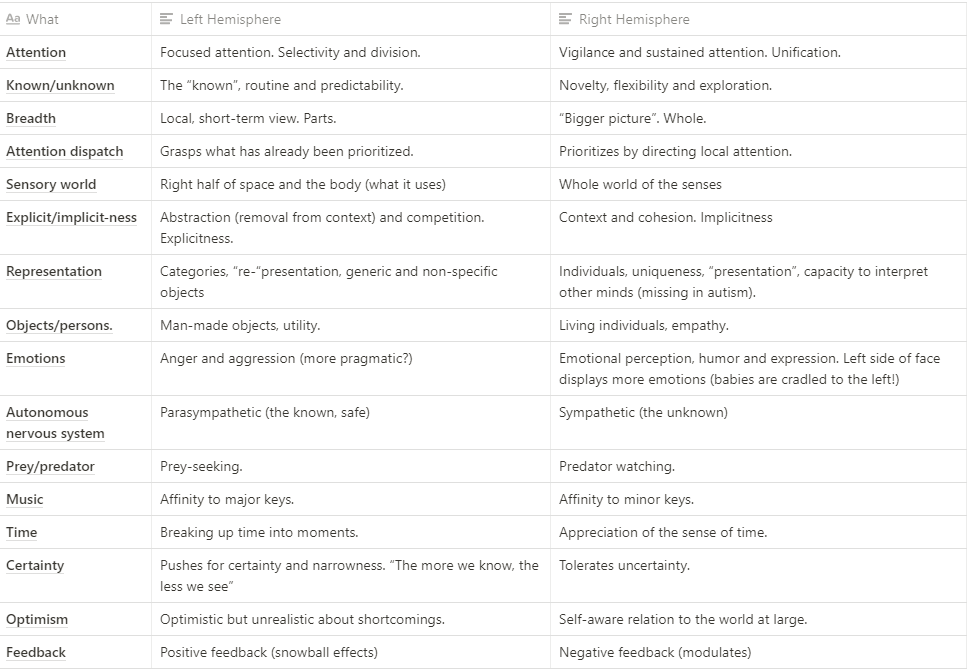
Table of Hemispheric Differences.
How do we attune? The devil is always in the details, as the Grandmothers would say. Boyd noted many of the components—genetics, biases, temperament, intelligence, mood, state, culture, etc. In addition, it is creativity, critical thinking, and metacognitive reflection. It is peeling away the cheesecloth of bias, taking off the cracked and smudged eyeglasses that are misframing the situation. As Boyd noted in the Strategic Game of ? and ?, Interaction is the critical piece, which is what Attunement is getting at. It is a bone deep alignment and posture of humility towards the Arena, which allows for the integration of many details, and for potential actions to present themselves.I have a good deal more work to do on developing this concept of Attunement, but I will leave it here for now.
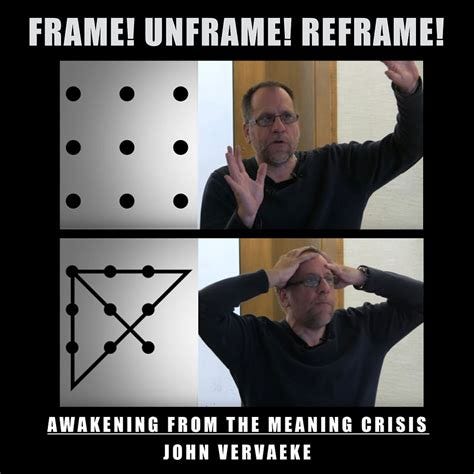
Boyd would say “Structure, Unstructure, Restructure!”
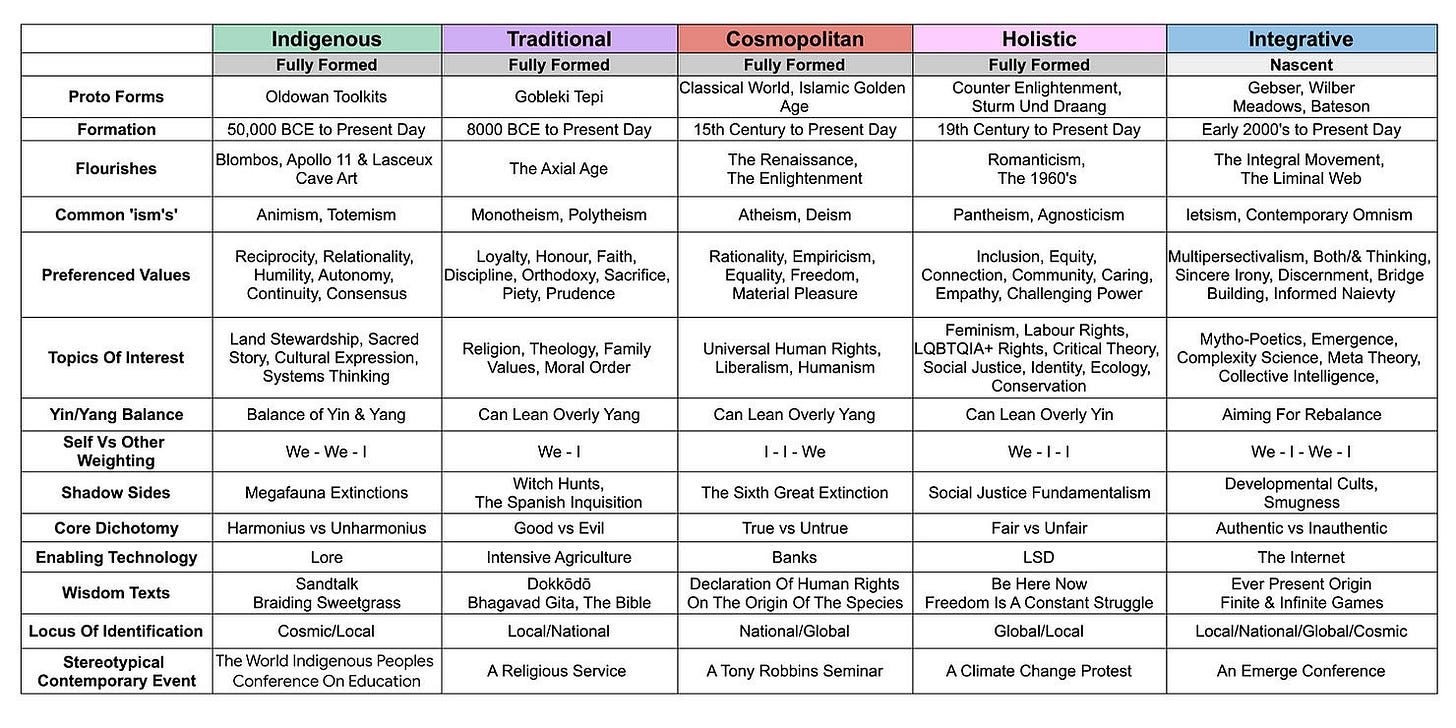
Joe Lightfoot’s Decidedly Non-Developmental Map of Worldviews
7. Five Worldviews: Worldviews and Metamemes are ways to describe ways of thinking about the world that have existed in the past and present. Lots to dig into here. Worldviews are one way that humans exercise their Agency in the world.
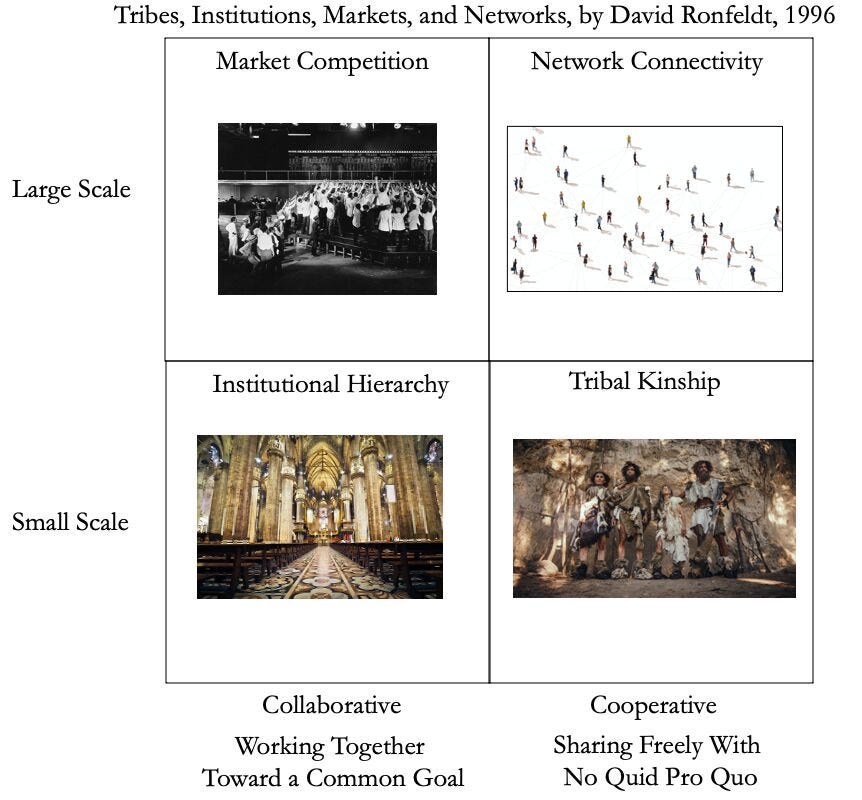
TIMN Framework
8. TIMN Framework: David Ronfeldt (Out with a hot new Substack here) has a thought-provoking model of how humans organize over time. Great illustration of how humans apply their agency on the world stage to affect their chosen outcomes. A lot to talk and think about here as we move into a time when all four of these models exist at the same time in various measures.
5 Paradigms of Communication and Information Processing
Oral- ??? to 500BCE
Scribal- 500BCE to 1550
Written- 1550 to 1850
Electric- 1850 to 2000
Digital- 2000 to ???
3 Spheres
East- The Tao, Eastern Traditions
West- The Virtues, Western Traditions
Digital- The Spark, New Tech
Trivium University Interests
9. Trivium University: An “online graduate program designed to shape classical thinkers able to lead in a world fundamentally altered by digital technology.” Headed by Mark Stahlman and Fred Beuttler, this organization seeks to shine a light on the changing times through the work of Marshall McLuhan and many other key thinkers. Find out more here. I’ve haven’t dug into this as much as I’d like to, but it looks very intriguing. Improving digital literacy and understanding the impact of new technology will be a critical part of humanity’s ability to succeed in the years to come, and I’m hopeful this project will aid in that effort.
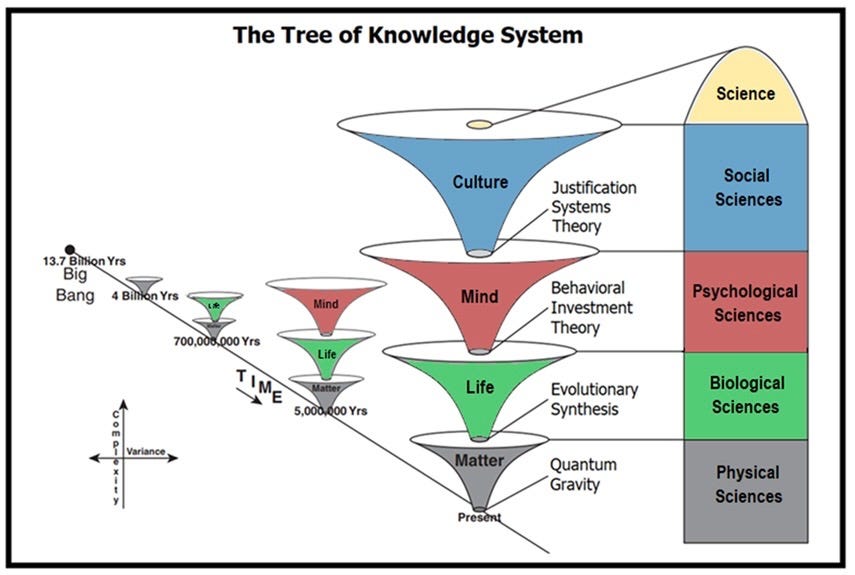
Unified Theory of Knowledge (UTOK) by Gregg Henriques
10. Bonus: Similar to the models in the Arena section, this is trying to show the progression of Agents within the Arena, as they slowly “complexify.” Consciousness assumes greater import, so we will go down the Biocentrism and Panpsychism rabbit holes later. There is so much to delve into with this theory—I recommend Jim Rutt’s Podcast to find relevant discussions of the salient points. There’s also Henrique’s medium posts on the topic here.
To reiterate, this is just an aperitif—I still need to work out the bugs. At the end of the day, it’s a messy muddle, and we’re all just trying to make sense of it the best that we can. The old expressions of the grandmothers and grandfathers are always, always the best. The wisdom of long decades, with the exuberance of youth and foolishness of temporality boiled off, until only the good stuff remains. Like: “wait awhile”, to denote taking a pause to reassess the context and particulars of a situation, and “in the final analysis, things resolve themselves in economics,” which denotes the inexorable demands of energy expenditure vs. gain. If I had to describe what I’m trying to do here, it would be a big churn of ideas, excavating what works from the past, and repurposing it for our use now.

